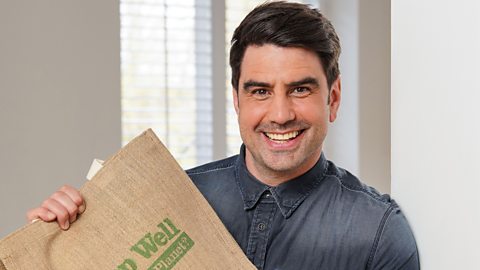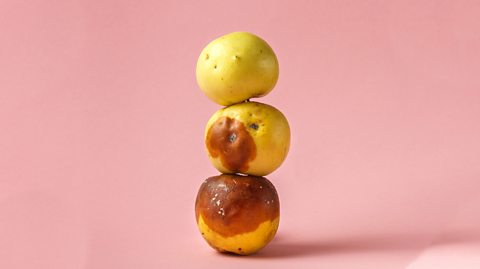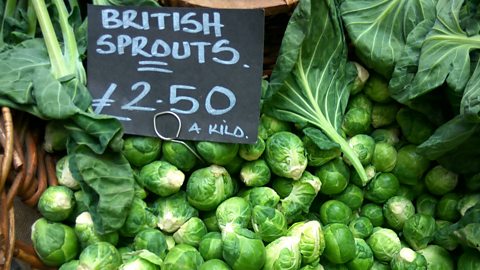4 simple ways to Shop Well for the Planet

Scientists recommend we slash our carbon footprint by more than half. Our diet accounts for 25 percent of our footprint ‚Äď so how can we reduce its environmental impact without increasing the cost of our food shop? ‚ÄúYou can make some big carbon reductions without [completely] altering your lifestyle,‚ÄĚ says Chris Bavin, co-presenter of ¬ť∂Ļ‘ľŇń One‚Äôs new series Shop Well for the Planet?. The show sees the worlds of Shop Well For Less? and Eat Well For Less? combine for the first time, as families try and test a variety of eco or more sustainable versions of the products they buy. Here are some of his top tips.
1. Eat everything you buy

‚ÄúFood waste is bad for the environment, bad for your pocket, and unnecessary,‚ÄĚ says Chris. ‚ÄúThe best way to reduce it is by planning.‚ÄĚ He suggests working out what you‚Äôre going to eat for the week, crucially involving everyone in your family or household in the decisions, then writing a shopping list and sticking to it.
You can also cut household food waste by buying fruit and veg loose, so you only get what you need. And you can help reduce supply chain waste by buying wonky veg, which might otherwise get thrown away, says Chris.
But what if you still have leftover produce before your next shop? Chris recommends making ‚Äúhashes, casseroles, stir-fries and pasta sauces,‚ÄĚ and freezing them.
2. Eat seasonal produce

‚ÄúEating seasonally is not new, cool or posh, it‚Äôs how we should all be eating,‚ÄĚ says Chris. Food grown locally in season doesn‚Äôt have to be shipped or flown in, or refrigerated to prolong shelf-life. Neither does it need to be grown in a fossil-fuel heated hothouse (though some hothouses use renewable energy, reducing their carbon footprint). Produce can be cheaper when it‚Äôs in season too, as gluts bring down prices, says Chris.
Food labels are unlikely to include information about transport, but they do state the country of origin. If it is far away, ask yourself if the produce is robust enough to have travelled by boat. If not, it may have been flown in. Out-of-season asparagus, green beans, mangetout, shelled peas, baby corn and berries are among the foods sometimes air-freighted. ‚ÄúWe can‚Äôt grow some things in the UK [‚Ķ], so just buy it from as close to home as possible,‚ÄĚ says Chris.
3. Cut back on meat and choose it carefully
A major 2019 report on land use and climate change says the West’s high consumption of meat and dairy produce is contributing to global warming. A document prepared by scientists for the UN’s says that if land is used differently, it can reduce the amount of carbon produced by our food.
The average farm animal converts 10 percent of the calories it eats into meat and dairy, according to Professor Mike Berners-Lee from the University of Lancaster. If animals are fed crops that could be eaten directly by humans, this is much less efficient than eating the plants ourselves.
Imported beef, especially from somewhere like Brazil, where cattle ranching is the main driver of deforestation both for keeping cattle and for producing soya to feed them, can have about three times the carbon footprint of British beef. So where meat is produced and what practices are used to produce it makes a big difference to its carbon cost. Most beef sold in the UK is farmed here (this information is usually on the packaging), and grass-feeding cattle is common in Britain, although it is often supplemented in the winter. Much British grazing land is also not suitable for growing crops. Bacon, pork and chicken have a lower carbon footprint than beef, according to Berners-Lee.
One meat-loving family in Shop Well for the Planet? decide to swap their lamb dhansak curry to a vegetarian alternative. According to the programme, swapping a weekly lamb curry for a family of four to a veggie curry could save half a tonne or more of CO2 equivalent a year*, depending on where the meat comes from, how it’s farmed, what veg you use, and of course how often you eat it.
‚ÄúWe‚Äôre not saying‚Ķ stop eating meat‚ÄĚ, says Bavin, ‚Äúbut having a couple of days off might do the environment‚Ķ and your pocket some good, [and] then you might be able to afford better quality or welfare meat when you do buy it‚ÄĚ. He adds, ‚Äúmeat is a great source of protein, but it‚Äôs not the only source‚Ķ I look to beans, pulses, legumes and grains,‚ÄĚ as they bulk out dishes and make them budget-friendly.
When it comes to cooking, Chris advises ‚Äúa lot of the flavour of meat comes from the fat, so when you remove this you need to think a bit more about flavourings‚ÄĚ. If you‚Äôre new to making meals without meat, ‚Äúuse ingredients that have meatier textures, like sweet potatoes, butternut squash and mushrooms‚Ķ If you roast them before adding to stews and curries, they‚Äôll hold their texture better.‚ÄĚ
4. Consider how you shop and wash up
If you buy ingredients loose, cooking from scratch can reduce your use of packaging, which is common with ready meals. If you‚Äôre new to home cooking, start with familar meals, such as Bolognese, or an easy curry or stir-fry. Also, ‚Äúmake your own coffee at home or bring a reusable mug to a shop,‚ÄĚ adds Chris.
You can reduce packaging by adjusting how you wash the dishes, too. A family on Shop Well for the Planet? replaces its usual dishwasher tablets with a plastic-free alternative. Some products and outlets also offer a refill service. Additionally, the family sets the dishwasher to its ‚Äėeco‚Äô setting, using less water at a lower temperature of 30 degrees, saving not only energy but money too.
* 800g of lamb, roughly the amount needed for a lamb curry for four, creates approximately 40kg of carbon equivalent, once it has been raised, slaughtered, packaged or processed, transported, refrigerated, purchased and cooked. The figure of half a tonne therefore assumes roughly a curry a month.
Shop Well for the Planet? starts on the 14 October at 8pm on ¬ť∂Ļ‘ľŇń One, or catch up on iPlayer.

This article was first published on 8th October 2021.